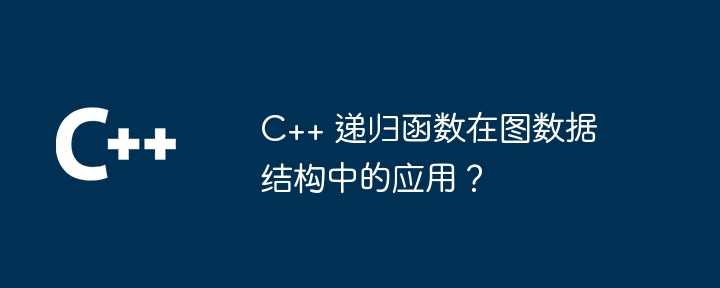Home >Backend Development >C++ >Application of C++ recursive functions in graph data structures?
Application of C++ recursive functions in graph data structures?
- WBOYWBOYWBOYWBOYWBOYWBOYWBOYWBOYWBOYWBOYWBOYWBOYWBOriginal
- 2024-04-17 18:33:011021browse
C Recursive functions are widely used in graph data structures, especially in algorithms such as depth-first search (DFS). The DFS algorithm traverses a graph by recursively exploring a node's neighbors and can be used to find paths, connected components, and cycles. The following C function implements the DFS algorithm: DFS(graph, node) {}, where graph is the graph and node is the current node. This function marks the current node as visited and recursively traverses all unvisited adjacent nodes.

C Application of recursive functions in graph data structures
Recursive functions are widely used in graph data structures, especially in graph traversal and search in the algorithm. This article describes how to use C recursive functions to perform a depth-first search (DFS) on a graph.
Depth First Search (DFS)
The DFS algorithm traverses the graph by recursively exploring all unexplored adjacent nodes of each node. This algorithm can be used to find paths, connected components, and cycles in graphs.
C recursive DFS function
The following C function implements the DFS algorithm:
void DFS(Graph& graph, int node) {
// 标记给定节点已访问
graph.visit(node);
// 递归遍历所有未访问的邻接节点
for (auto adjacent_node : graph.get_adjacent_nodes(node)) {
if (!graph.is_visited(adjacent_node)) {
DFS(graph, adjacent_node);
}
}
}Practical case
Consider the following undirected graph:
1 -- 2 | / | 3 -- 4
To DFS this graph, we need to start with a node and recursively visit all its unvisited adjacent nodes:
Graph graph; // 添加节点和边 graph.add_edge(1, 2); graph.add_edge(1, 3); graph.add_edge(2, 4); graph.add_edge(3, 4); // 从节点 1 开始 DFS DFS(graph, 1);
DFS will print the following access sequence: 1, 2, 4, 3
Conclusion
Recursive functions provide a concise and powerful way to implement various traversal and search algorithms in graph data structures. This article describes how to perform DFS using C recursive functions and provides a practical case to illustrate its application.
The above is the detailed content of Application of C++ recursive functions in graph data structures?. For more information, please follow other related articles on the PHP Chinese website!

